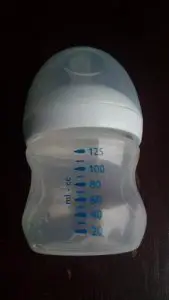Table of Contents
The Avent Nipples
AVENT nipples are undeniably the best ones out there; they have always been known to have high-quality feeding bottles and nipples.
Avent Nipple Sizes
There is a variety of nipple sizes with corresponding age recommendations and flow. Avent nipples are made of durable food-grade silicone that is comfortably soft, odorless, and tasteless. Aside from various available shapes, Avent nipples also come in six different sizes, including first flow or preemie, newborn flow, slow flow, medium flow, fast flow, and variable flow. These Avent nipples are also incorporated with a flexible spiral.
Natural First Flow Nipple
The first flow nipple, also known as a preemie, is most suitable for premature babies or newborns. This nipple has the smallest hole with the slowest and most controlled flow rate of milk. For small newborn babies or premature ones, the smallest Avent nipple will be the best fit for them. This nipple size is best for babies who are still days to weeks old.
Natural Newborn Flow Nipple
This nipple size is ideal for babies who are being fed with a combination of breastfeeding and bottle-feeding. The Avent natural newborn flow has one hole to maintain slow milk flow, so this is perfect for bottle-feeding babies who are zero to three months old.
Natural Slow Flow
The natural slow flow nipples are also recommended if you plan on combining breastfeeding and bottle-feeding. This one has two holes but still produces a slow milk flow. This nipple size is also suitable for babies who are zero to three months old. If your baby is having a hard time with this nipple size, you may switch back to the newborn flow.
Natural Medium Flow
The Avent Natural Medium Flow nipple is perfect for infants who are already three months and older. It is created with a flexible and still a spiral design. This medium flow works to mimic mothers’ breasts to make switching easier. The Natural Medium Flow has three holes instead of one. These holes allow the milk to flow at a moderate pace.
Natural Fast Flow
Avent recommends that babies who are already six months and older will use the natural fast flow nipple. As the name suggests, this nipple produces a quicker flow than the rest of the nipple sizes. This nipple also an integrated Airflex Vent technology to avoid colic.
Natural Variable Flow
The natural variable flow nipple is different from the rest of the nipple sizes since it has a combined slot hole. This nipple makes it easy to get the flow suitable for your baby since you can adjust the feeding bottle to line up with the proper markings. The different marks indicate slow, medium, or fast flow. The holes open wider with added suction, but its normal flow is comparable to the natural medium flow ones.
When to Change Nipple Sizes
Changing nipple sizes is as important as changing your baby’s clothing size; the right nipple size plays a massive part in efficiency and comfort. Figuring out when to change the nipple size might be confusing, but after reading this, you’ll be surprised at how easy this can be.
- For breastfeeding moms transitioning or planning to switch from time to time, the Newborn nipple will work great since it is created to mimic the mother’s regular milk flow.
- If you notice your baby becoming impatient or frustrated during feeding, if finishing the bottle takes longer than thirty minutes, this may indicate that the nipple size is too small, therefore producing a slower milk flow. You may want to try the next size or the one with a faster flow.
- You may want to switch to a slower flow nipple size if you have noticed your baby struggling when being bottle-fed and becoming too gassy and fussy. More spit-ups, choking, gagging, or spilling milk indicates that the nipple flow rate might be too fast. If you happen to notice these, you might want to downsize or switch to a nipple with a slower flow rate.
Other things to consider
If you have observed that your baby is unhappy or not contented with the nipple size even after switching and changing a couple of times, then the nipple size might not be the problem. You might want to check and try different types of nipples, such as angled nipples or orthodontic nipples. You may also want to consider length, and shape.
Other tips
Not only should you change your nipples when the size is not right, but you are also advised to change your bottle nipples every three months or if you notice signs of wear and tear. This practice will also ensure that your baby bottle nipples perform at its best and are safe for your baby. Always sanitize your baby’s bottle nipples. It would be best if you kept them fresh and clean.
- Discard nipples that have enlarged holes or deformities. These enlarged holes will result in an abnormal flow.
- It is a great idea to keep different nipple sizes with you. You’ll never know when your baby will need them.
- Always pay attention to your baby when feeding, this will not only help you determine the suitable baby bottle nipple for them, but this will also ensure their comfort and safety when feeding
Conclusion
Being able to choose what’s best for our kids is every mother’s goal! That’s why choosing the perfect Avent nipple size together with choosing the right bottle is important since it makes feeding time comfortable for babies and parents! The best nipple sizes generally make feeding time satisfying, easy, and enjoyable.
So make sure to get the perfect Avent nipples size for a perfect bottle-feeding time!

